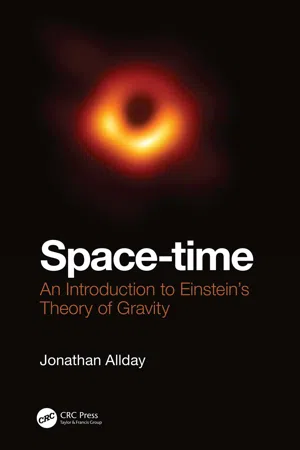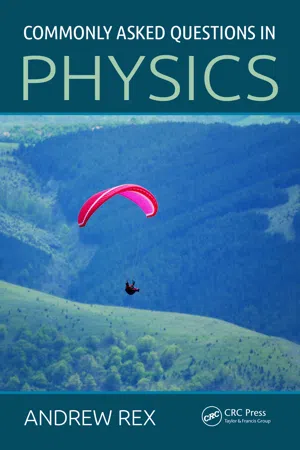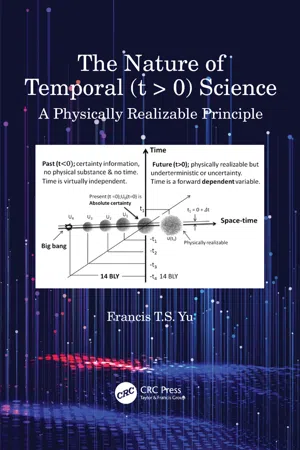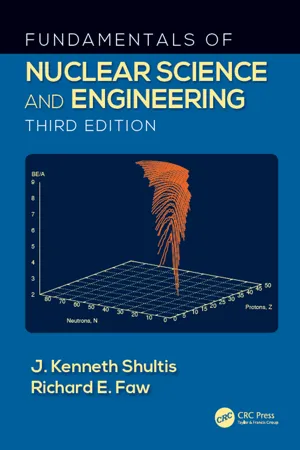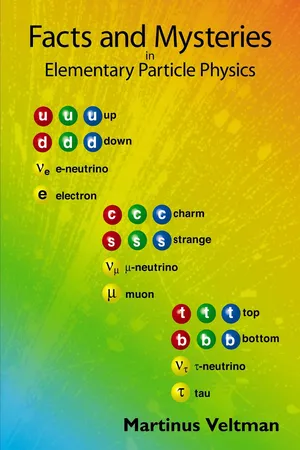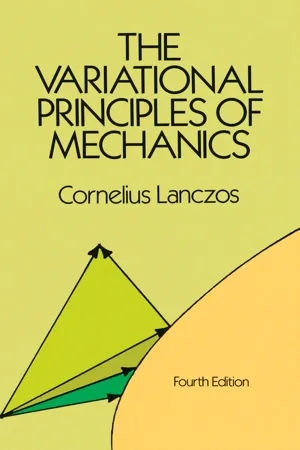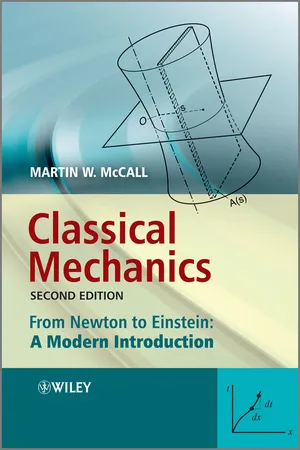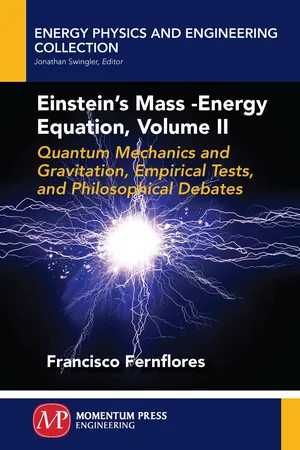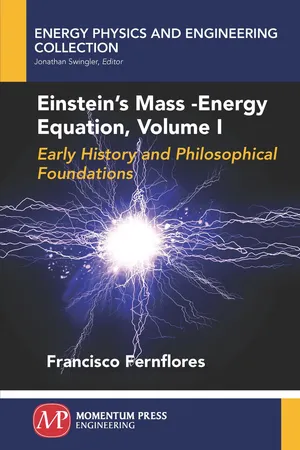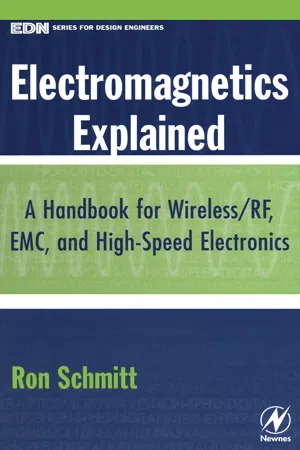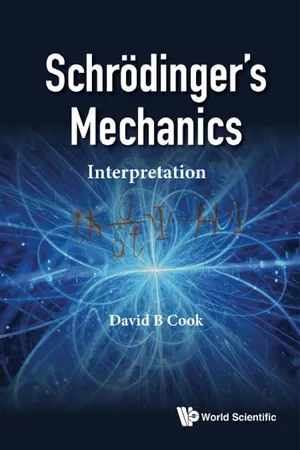Physics
Relativistic Mass and Energy
Relativistic mass and energy are concepts in physics that arise from Einstein's theory of special relativity. They describe how an object's mass and energy change as its velocity approaches the speed of light. According to this theory, as an object's velocity increases, its mass and energy also increase, leading to the famous equation E=mc^2.
Written by Perlego with AI-assistance
Related key terms
11 Key excerpts on "Relativistic Mass and Energy"
- eBook - ePub
Space-time
An Introduction to Einstein's Theory of Gravity
- Jonathan Allday(Author)
- 2019(Publication Date)
- CRC Press(Publisher)
Chapter 6 .5.3.3 Mass and Rest Mass
Whatever this internal energy is, it is parcelled up inside the particle and gives it the mass we measure when it is at rest: the rest mass, m 0 .As we add energy to the particle, by accelerating it for example, its mass will increase. We can see this from our momentum equation if nothing else:P 1= γm 0u ==m 0u1 −/u 2c 2m uu ,whereis the mass at a speed u , sometimes called the relativistic mass .m u=m 0/1 −u 2/c 2While this is a perfectly valid approach to the issue of mass, it is not the only possible view. Our colleagues in the particle physics community refer to rest mass as the mass of the particle, as the value is a characteristic property of the species concerned. For a particle in motion, particle physicists tend to work with the energy and momentum rather than worrying about the mass in such circumstances. We will follow their pattern.11Interestingly, Einstein was not keen on the idea of relativistic mass as the quantity cannot be directly measured:It is not good to introduce the concept of the massM =of a moving body for which no clear definition can be given. It is better to introduce no other mass concept than the ʻrest mass’ m . Instead of introducing M it is better to mention the expression for the momentum and energy of a body in motion.12m /1 −v 2/c 2In a comparatively modern text on the subject, Taylor and Wheeler13 take the view:The concept of “relativistic mass” is subject to misunderstanding. That’s why we don’t use it. First, it applies the name mass – belonging to the magnitude of a 4-vector – to a very different concept, the time component of a 4-vector. Second, it makes increase of energy of an object with velocity or momentum appear to be connected with some change in internal structure of the object. In reality, the increase of energy with velocity originates not in the object but in the geometric properties of space-time itself. - eBook - ePub
- Andrew Rex(Author)
- 2014(Publication Date)
- CRC Press(Publisher)
Chapter 9 Relativity Relativity is one of the most important and fascinating fields of study within physics. It’s generally split into two subfields—special relativity and general relativity—both of which were developed by Albert Einstein in the early twentieth century. Relativity accounts for how events are viewed from different frames of reference, when those frames of reference are moving with respect to one another or in strong gravitational fields. It also accounts for how light will appear to observers in different frames of reference. Many of the effects predicted by the theory of relativity are contrary to the predictions of classical physics and to perceptions based on everyday experience. These striking and sometimes shocking predictions have been verified repeatedly by experimental evidence. Probably the most famous prediction of special relativity is the equivalence of mass and energy, expressed in the formula E = mc 2. This equivalence manifests itself in many ways, particularly in atomic and nuclear physics (Chapter 7) and in the study of fundamental particles (Chapter 8). The implications are far reaching and include the production of nuclear energy and nuclear weapons. What’s the Difference between Special Relativity and General Relativity? Special relativity accounts for how material objects and light are viewed by observers traveling in different frames of reference, in constant, nonaccelerated motion with respect to one another. The fact that the speed of light is the same for observers in all reference frames is of fundamental importance. It leads to correct predictions about how the different observers measure the positions, lengths, and velocities of objects, and how they measure the passage of time - eBook - ePub
The Nature of Temporal (t > 0) Science
A Physically Realizable Principle
- Francis T.S. Yu(Author)
- 2022(Publication Date)
- CRC Press(Publisher)
where E is energy, M is mass, and c is the velocity of light. From this we see that our current science is limited by the speed of light. The fact is that Einstein's energy equation had given us the fundamental limit of energy; that is, mass and energy are equivalent. In this one of most famous and important equations that more than haft the world's population may have known it but many of them may not actually understand its physical significance. Anyway, this equation strictly speaking it is not consistent with a physically realizable axiom of our temporal (t > 0) universe since the special theory was developed from a non-physically realizable paradigm as I had shown. Yet the physical significance of Einstein's energy equation remains; energy and mass are equivalent.5.5 A New Mass Energy Equation
It is trivial that Einstein's relativity equation can be written in a relativistic mass formula as given by:M =(5.14)M 0(1 −)v 2/c 2− 1 / 2where M is the effective mass (or mass in motion), Mois the rest mass, v is the velocity of the moving M, and c is the speed of light. In other words, the effective mass of a moving particle increases at the same amount with respect to the relativistic time window Δt′ (i.e., time dilation). Since Einstein's special theory was developed within an empty subspace, it has no induced gravitational field, as can be seen in Figure 5.11(a) . Besides, it is not a physically realizable subspace paradigm, and it is trivial that empty space cannot support an induced gravitational field. In contrast, if it is situated within a temporal (t > 0) subspace shown in Figure 5.11(b), an induced gravitational field F is inherently attached with a temporal (t > 0) mass M(t) in motion.Figure 5.11 - eBook - ePub
- J. Kenneth Shultis, Richard E. Faw(Authors)
- 2016(Publication Date)
- CRC Press(Publisher)
If the particle was also in some potential field, for example, an electric field, the total energy would also include the potential energy. Thus one has E = m c 2. (2.11) This well known equation is the cornerstone of nuclear energy analyses. It shows the equivalence of energy and mass. One can be converted into the other in precisely the amount specified by E = mc 2. When we later study various nuclear reactions, many examples of energy being converted into mass and mass being converted into energy will be seen. Example 2.2: What is the energy equivalent in MeV of the electron rest mass? From data in Table 1.5 and Eq. 1.1 one finds E = m e c 2 = (9.109 × 10 − 31 kg) × (2.998 × 10 8 m / s) 2 × (1 J / (kg m 2 s − 2) / (1.602 × 10 − 13 J / MeV) = 0.5110 MeV When dealing with masses on the atomic scale, it is often easier to use masses measured in atomic mass units (u) and the conversion factor of 931.49 MeV/u. With this important conversion factor one obtains E = m e c 2 = (5.486 × 10 − 4 u) × (931.49 MeV/u) = 0.5110 MeV. Reduction to Classical Mechanics For slowly moving particles, that is, v ≪ c, Eq. (2.10) yields the usual classical result. Since, 1 1 − v 2 / c 2 ≡ (1 − v 2 / c 2) − 1 / 2 = 1 + v 2 2 c 2 + 3 v 2 8 c 2 + 3 v 2 8 c 2 + ⋯ ≃ 1 + v 2 2 c 2, (2.12) the kinetic energy of a slowly moving particle. is T = m o c 2 (1 1 − v 2 / c 2 = 1) = m o c 2 ([ 1 + v 2 2 c 2 + ⋯ ] − 1) ≃ 1 2 m o v 2. (2.13) Thus the relativistic kinetic energy reduces to the classical expression for kinetic energy if v ≪ c, a reassuring result since the validity of classical mechanics is well established in the macroscopic world. Relation Between Kinetic Energy and Momentum Both classically and relativistically, the momentum p of a particle is given by p = m v. (2.14) In classical physics, a particle’s kinetic energy T is given. by T = m v 2 2 = p 2 2 m, which yields p = 2 m T. (2.15) For relativistic particles, the relationship between momentum and kinetic energy is not as simple - Martinus J G Veltman(Author)
- 2003(Publication Date)
- WSPC(Publisher)
x and the relative velocity of the systems. In this sense the mass-shell is an invariant: a particle of given mass remains on the same mass-shell when going to another reference system. For a particle of zero mass we have the light cone, and going to a differently moving system a point on the cone (for which energy equals the magnitude of the momentum) will become another point on the cone (where again energy equals the magnitude of the momentum). The values of energy and momentum however will of course be different.We have thus a number of invariances in physics. The invariance of the laws of physics with respect to rotations and with respect to systems moving with a constant speed relative to each other is now generally called Lorentz invariance. Including invariance with respect to translations in space and time one speaks of Poincaré invariance. Both Lorentz and Poincaré made their contributions prior to Einstein; it is Einstein who invented relativistic kinematics and made us understand the whole situation in full clarity.Invariance with respect to relative movement can be used with advantage to understand certain situations. If some physical process is forbidden (or allowed) in some system it is forbidden (or allowed) in systems that move relative to that original system. For example, if some decay process does not occur if a particle is at rest it will also never occur if it moves; we shall effectively use this seemingly trivial observation to clarify complex situations. Deducing things in the most convenient reference frame is often of great help in particle theory.4.5 The Relation E = mc 2The equation E = mc 2 is surrounded by mystique, and there is the folklore that this equation is somehow the starting point for making an atomic bomb. It might not do any harm to explain this equation in some detail, to demystify it.In the simplest possible terms this equation means that energy has mass. Given that the weight of an object is proportional to its mass this means that energy has weight. Consider an old-fashioned watch, with a spring that must be wound regularly. When the spring is completely unwound, measure the weight of the watch. Then wind it, meaning that you put energy into the spring. The energy residing in the spring has some weight. Thus if you measure the weight of the watch after winding the spring it will be a little heavier. That weight difference is very small but non-zero.c- eBook - ePub
- Cornelius Lanczos(Author)
- 2012(Publication Date)
- Dover Publications(Publisher)
53.12 ):In our case we obtainThis celebrated result of Einstein represents one of the most important discoveries of theoretical physics. Whereas in Newtonian physics the kinetic energy of a particle appeared in the form which indicates that a mass achieves energy only by its motion, the new equation (95.13 ) puts the enormous quantity me1 in front of the Newtonian term, thus demonstrating that a mass, by its very existence, is the seat of a tremendous amount of energy, compared with which the ordinary kinetic energy is usually negligibly small. Considering the ease with which the various forms of energy may be transformed into each other, the possibility of converting the latent energy, associated with a given mass, into other energy forms appeared on the horizon. The successful construction of the atom bomb tragically confirmed this conclusion of relativity.Since c = 3×1010 cm./sec., the conversion of one gram of matter into energy amounts to 9×1020 ergs = 9×1012 joules = 25 million kilowatt-hours = 21,500 million kilogram-calories.A further fundamental conclusion can be drawn from the canonical integrand (cf. 64.3 ), which can be rewritten in mathematical coordinates:The four components of the 4-momentum must have invariant significance by being the four components of a 4-vector. Indeed, we obtain from (95.11 ) and (95.13 - eBook - ePub
Classical Mechanics
From Newton to Einstein: A Modern Introduction
- Martin W. McCall(Author)
- 2011(Publication Date)
- Wiley(Publisher)
If we are uncomfortable with the notion of free particles at rest having energy then perhaps we could redefine energy as E ′ = γmc 2 − mc 2. But it’s too late! Conservation of E total is forced by Equation (6.9) – see the comments just before Equation (6.12) – and this requires E = γmc 2. Any redefinition at this stage would lead to an ‘energy’ that is not conserved in an isolated system. In fact the quantity γmc 2 − mc 2 does have significance as it is that part of the total energy that is due to the motion of a body in a given frame, so it is appropriate to define this to be the relativistic expression for kinetic energy : The kinetic energy, K, of a particle of mass m, moving with speed v, is given by (6.16) But what about the rest energy, E rest = mc 2 ? What does Equation (6.15) mean ? 6.2 The Meaning of Rest Energy Now with the energy defined we can dispense with F and rewrite Equation (6.9), after using Equations (6.10) and (6.13) and rearranging slightly as (6.17) For a single particle, m sys is simply the particle’s rest mass in which case (6.18) Equation (6.17) inextricably relates the momentum and energy of a system to its rest mass. Despite its apparent triviality, the experimental observation that an isolated box of gas does not change its weight has profound consequences. What if other forms of energy are present in the box? It may contain electromagnetic radiation, or springs compressed by masses, and together all these energy sources will be interacting and exchanging with each other. Whereas in Newtonian physics we had to invent new forms of energy to preserve its conservation, in relativity these extra forms are already accounted for once it is established experimentally that the rest mass and momentum of an isolated system are conserved - eBook - ePub
- Francisco Fernflores(Author)
- 2017(Publication Date)
- Momentum Press(Publisher)
1.2 of Volume 1), it is a short step to the conclusion that electromagnetic energy will gravitate, i.e., that electromagnetic energy, like all energy, has gravitational mass. For example, an electrically charged body will have a larger inertial mass, and hence a larger gravitational mass, than an identical body without the corresponding net electric charge.In outlining the different parts of his review article, Einstein tells us that “the fourth part deals with the general inferences regarding the energy and momentum of physical systems to which one is led by the theory of relativity” [7, p. 254]. He then tells us that the most important result concerns “the inertial mass of the energy,” which raises the question of “whether energy also possesses heavy (gravitational) mass.” The question is one that Einstein will clearly answer in the affirmative.When we turn to the fourth section of the paper, we see that Einstein first demonstrates the mass–energy relation and concludes: “With respect to inertia, a mass μ is equivalent to an energy content of magnitude μc 2 ” [7, p. 287]. In his discussion of possible ways of verifying this relation, all of which he deems to be well beyond then current experimental accuracy, he begins to make the connection between energy and gravitational mass.Einstein has, in effect, considered rather rudimentary experiments one can imagine for testing the mass–energy relation. For example, one might allow a sample of radium to radiate for long time, and measure its mass at the beginning and end of that time to determine whether the energy emitted is numerically equal to the mass lost. However, to perform such an experiment, Einstein points out, “It has been tacitly assumed above that such a change in mass can be measured by the instrument we usually use for measuring masses, i.e., by the balance” [7, p. 288]. The significance of this is clear. The assumption is that the mass–energy relation obtains “not only for the inertial mass but also for the gravitational mass, or, in other words, that a systems inertia and weight are strictly proportional under all circumstances” [7, p. 288]. Einstein then explains that one of the consequences of this is that, e.g., what we today call a photon gas has “not only inertia but also weight” [7, p. 288]. - eBook - ePub
- Francisco Fernflores(Author)
- 2017(Publication Date)
- Momentum Press(Publisher)
A close examination of Einstein’s argument shows, however, that the only relativistic result or presupposition that Einstein uses is that energy has inertia. In other words, unlike the first demonstration of his mass–energy relation, in this argument, Einstein only uses the expression for the radiation pressure and the conservation of momentum. His argument does not, e.g., rely on either the principle of relativity or the light principle. Einstein himself recognized this. For example, in “The Theory of Relativity,” from 1911, Einstein says:However odd this result might seem, still, in a few special cases, one can unequivocally conclude from empirically known facts, and even without the theory of relativity , that the inertial mass increases with energy content [30 , p. 350, emphasis added].Although Einstein does not identify them, the “empirically known facts” include Maxwell theory of electromagnetism, i.e., Maxwell’s equations, the law of radiation pressure and the attendant fact that light carries momentum, and the conservation of motion for the center of gravity of an object.2.4 A THIRD DEMONSTRATION
In a manuscript on the special theory of relativity from 1912, Einstein uses yet another thought experiment to demonstrate the mass–energy relation [31] . The physical system Einstein now considers is very similar to the one he used in his original demonstration in 1905. However, the details of the demonstration are different.Einstein considers a plate at rest relative to an inertial coordinate system Σ′. The surfaces of the plate have surface area f and the plate is oriented in space so that it is perpendicular to the x ′ axis. As in his original demonstration, Einstein asks us to consider two equally energetic “wave-trains” of electromagnetic radiation, each of spatial extent l ′ as measured along the x ′-axis, being emitted from each of the two lateral surfaces. Because the emission of light occurs in equal and opposite directions, although light carries momentum, the plate will remain at rest in Σ′. Having thus already appealed to the principle of conservation of momentum, Einstein goes on to use the principle of conservation of energy, and the expression for the energy of a charged body, to demonstrate the inertia of energy.Einstein considers the act of emission with respect to an inertial coordinate system Σ that moves with velocity v relative to Σ′. Einstein first shows that if l 1 is the spatial extent of the wave-train of the radiation that moves along the positive x - eBook - ePub
Electromagnetics Explained
A Handbook for Wireless/ RF, EMC, and High-Speed Electronics
- Ron Schmitt(Author)
- 2002(Publication Date)
- Newnes(Publisher)
A famous riddle of relativity is that of the “twin paradox.” Assume that the astronaut mentioned earlier is your twin brother. He makes the trip to the distant star and then immediately turns back. Upon his arrival you are 20 years older but he is only about 3 years older. If motion is relative, why are you now of different ages? Doesn’t this point out a contradiction in relativity? The answer is no. Uniform, straight-line motion is relative, but not all motion is relative. Upon starting his trip, your twin must have accelerated. He also must have experienced acceleration when he turned around at the distant star and when he slowed down on arriving back at earth. During these periods of acceleration, a force must have acted on the rocket and him. It is during these periods of acceleration that his space-time reference frame changes relative to yours. When he is coasting in uniform motion, the motion is relative, but during acceleration, he feels his “stomach drop” while you feel nothing. Accelerated motion is special and is not inherently relative. As always, it is during acceleration that nature “balances her books.”Space-Time, Momentum-Energy, and Other Four-Vectors
You already learned that space and time form a single four-dimensional structure. Events in space-time can be described by a four-dimensional quantity called a 4-vector: = [x,y,z,ct], The length of a 4-vector is calculated using the Minkowski metric, which you learned about earlier in the chapter. Part of the beauty of relativity is that all the fundamental quantities of physics are condensed using 4-vectors. For example, the proper time derivative of 4-position gives proper 4-velocity:where γ is the stretch factor. Multiplying 4-velocity by proper mass, mo , produces 4-momentum:Proper mass is also known as rest mass. Relativistic mass is defined as m = γmo. When you travel at high speed, your relativistic mass increases, but your proper mass, the mass that you feel in your reference frame, always stays the same. Substituting relativistic mass and multiplying by c, the fourth component of the four momentum becomes:mc2 ,Einstein’s famous equation for energy. Therefore, 4-momentum is often called the momentum-energy vector. The derivative of 4-momentum produces the 4-force, whose 4th component, when multiplied by c, gives the relativistic power. The laws of physics are dramatically condensed with relativity.ELECTRIC FIELD AND MAGNETIC FIELD BECOME THE ELECTROMAGNETIC FIELD
The 4-vector concept also allows us to condense the mathematics of electromagnetics, and reveals the true nature of the electromagnetic field. By combining the magnetic vector potential with voltage into a four vector:= [Ax ,Ay ,Az , V/c],a single electromagnetic potential is formed. Using this 4-potential, the electric and magnetic fields combine to form a single electromagnetic field, which can be represented by a mathematical object called a tensor. In the mathematical system called Clifford geometry, the electromagnetic field can be written simply as F = E + icB, where i = - eBook - ePub
Schrödinger's Mechanics
Interpretation
- David B Cook(Author)
- 2018(Publication Date)
- WSPC (EUROPE)(Publisher)
T, say) sincethe question is: is there a relativistic equivalent which links |P|2 to the kinetic energy of a ‘relativistic particle’? In fact the corresponding equation linking P, when due allowance is made for the variation of mass and momentum via the Lorentz transformation, involves the squares of both the energy and the momentum:which includes Einstein’s famous formula for the energy a stationary particle (E0 = m0 c2 ) which provides the intrinsic energy of mass m0 , the remaining contribution to the total energy (E). By making the now routine replacement of each component of the energy/momentum vector by the familiar HJE method, this will provide a set of operators and therefore a way to develop a ‘Schrödinger-like’ equation which satisfies the requirements of SR:and E byBut, awkwardly, each operator appears squared in the equation which leads to difficulties. However, it is clear that the LHS of Equation (7.5) is expressed as |P|2 , the square of the modulus of P but what is needed is the operator P not its modulus. It has been shown in Chapter 6
Index pages curate the most relevant extracts from our library of academic textbooks. They’ve been created using an in-house natural language model (NLM), each adding context and meaning to key research topics.
